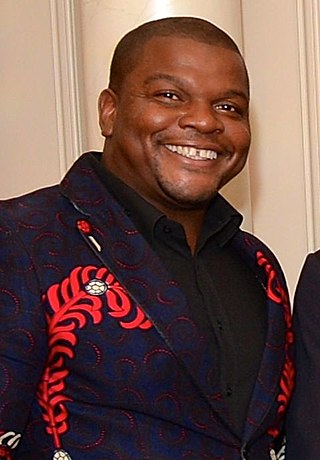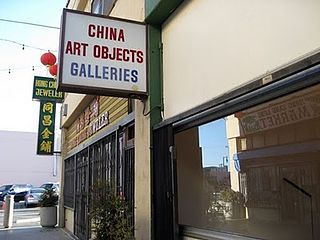
Kehinde Wiley is an American portrait painter based in New York City. He is known for his naturalistic paintings of black people that reference the work of Old Master paintings. In 2017, Wiley was commissioned to paint former President Barack Obama's portrait for the Smithsonian National Portrait Gallery. The Columbus Museum of Art hosted an exhibition of his work in 2007 and describes his paintings as "heroic portraits which address the image and status of young African-American men in contemporary culture."

Betye Irene Saar is an American artist known for her work in the medium of assemblage. Saar is a visual storyteller and an accomplished printmaker. Saar was a part of the Black Arts Movement in the 1970s, which engaged myths and stereotypes about race and femininity. Her work is considered highly political, as she challenged negative ideas about African Americans throughout her career; Saar is best known for her artwork that critiques anti-Black racism in the United States.
Alison Saar is a Los Angeles-based sculptor, mixed-media, and installation artist. Her artwork focuses on the African diaspora and black female identity and is influenced by African, Caribbean, and Latin American folk art and spirituality. Saar is well known for "transforming found objects to reflect themes of cultural and social identity, history, and religion." Saar credits her parents, collagist and assemblage artist Betye Saar and painter and art conservator Richard Saar, for her early exposure to are and to these metaphysical and spiritual practices. Saar followed in her parents footsteps along with her sisters, Lezley Saar and Tracye Saar-Cavanaugh who are also artists. Saar has been a practicing artist for many years, exhibiting in galleries around the world as well as installing public art works in New York City. She has received achievement awards from institutions including the New York City Art Commission as well as the Institute of Contemporary Art in Boston.
Faris McReynolds is a Los Angeles-based artist and musician. His paintings have been shown in solo exhibitions around the world and have been featured in Details, Art Papers, Flash Art Magazine, Tema Celeste, and ArtWeek.
Craft Contemporary, formerly the Craft and Folk Art Museum, is a non-profit, non-collecting arts museum dedicated to showcasing contemporary craft in Los Angeles, California. The museum is located on Los Angeles' Museum Row on Wilshire Boulevard, and across from the George C. Page Museum and La Brea Tar Pits. It is the only institution on the West Coast of the United States to focus exclusively on craft.

Jimmy Baker is an associate professor in the Studio Department at the Art Academy of Cincinnati. He has exhibited work in New York, Los Angeles, Paris, London, Basel, Miami, Chicago, Dallas, and other American cities. His work has been featured in many publications, private collections, as well as permanent collections at the Crystal Bridges Museum of American Art, Zabludowicz Art Trust London, Taschen Foundation Berlin, Cincinnati Art Museum, Columbus Museum of Art, JP Morgan Chase Collection, and Progressive Insurance Collection.
Eric Yahnker is a contemporary artist born in 1976 in Torrance, California. His humorous, meticulously rendered graphite and colored pencil drawings and elaborate process pieces examine pop culture and politics. His work is represented by Ambach & Rice in Los Angeles, where he was included in an exhibition with Erwin Wurm and Raymond Pettibon in 2010.

China Art Objects Galleries is a contemporary art gallery co-founded by a group of artists in Los Angeles in 1999. Founder Steve Hanson moved the gallery to Mérida, Mexico in 2021.

Jeffrey Deitch is an American art dealer and curator. He is best known for his gallery Deitch Projects (1996–2010) and curating groundbreaking exhibitions such as Lives (1975) and Post Human (1992), the latter of which has been credited with introducing the concept of "posthumanism" to popular culture. In 2010, ArtReview named him as the twelfth most influential person in the international art world.
Dale Brockman Davis is a Los Angeles–based African-American artist, gallerist and educator best known for his assemblage sculpture and ceramic work that addresses themes of African American history and music, especially jazz. Along with his brother, artist Alonzo Davis, he co-founded Brockman Gallery in Leimert Park. Through the gallery and his broader community work, Davis became an important promoter of African-American artists in Los Angeles.
John Havemeyer Tilton Jr was an American art dealer based in New York City who in 1983 founded Jack Tilton Gallery.

Lezley Irene Saar is an African American artist whose artwork is responsive to race, gender, female identity, and her ancestral history. Her works are primarily mixed media, 3-dimensional, and oil & acrylic on paper and canvas. Through her artistic practice Lezley explores western and non-western concepts of beauty, feminist psychology and spirituality. Many works conjure elements of magical realism. She has exhibited widely in the U.S. and internationally. Her work is included in museum collections such as The Kemper Museum, CAAM, The Ackland Art Museum, the Smith College Museum of Art, the Studio Museum in Harlem and MOCA. She is currently represented by Walter Maciel Gallery in Los Angeles and Various Small Fires in Asia.

Noah Davis, was an American painter, installation artist, and founder of the Underground Museum in Los Angeles. When talking about his work, Davis has said, "if I’m making any statement, it’s to just show black people in normal scenarios, where drugs and guns are nothing to do with it," and describes his work as "instances where black aesthetics and modernist aesthetics collide." Davis died at his home in Ojai, California, on August 29, 2015, of a rare form of soft tissue cancer.

Destination Crenshaw is an under-construction 1.3-mile-long (2.1 km) open-air museum along Crenshaw Boulevard in Los Angeles, California, dedicated to preserving the history and culture of African Americans. The project includes new pocket parks, outdoor sculptures, murals, street furniture, and landscaping.
The Rubell Museum, formerly the Rubell Family Collection, is a private contemporary art museum with locations in the Allapattah neighborhood of Miami, Florida, and the Southwest Waterfront neighborhood of Washington, D.C. Opened to the public in 1993 and formerly housed in a warehouse in the Wynwood Art District, the museum and its collection were developed by Mera and Don Rubell, Miami-based art collectors who have played a significant role in the city's development as a center of the international contemporary art market. The museum relocated to a significantly larger campus in Miami, and opened a campus in Washington, in 2019 and 2022, respectively.
Mariane Ibrahim-Lenhardt is a Somali-French art dealer based in Chicago, Illinois. She runs the eponymous Mariane Ibrahim Gallery.
Gloria Racine Bohanon was an American visual artist and educator based in Los Angeles, California. She was born in Atlanta, Georgia. She received a BA in Art Education and an MA in Art Education from Wayne State. She also studied at Otis College of Art and Design in 1973. She was an active member of the Los Angeles contemporary art scene in the 1970s. As a professor at Los Angeles Community College, she organized "Black Culture Week" in 1974. She taught design, painting, printmaking, and served as chair of the Arts Department while there. She was the director of ADAPT, an organization for disabled students while at LACC.

Black Art: In the Absence of Light is a 2021 American documentary film, directed and produced by Sam Pollard. The film follows various Black American artists and their contributions to the art world.

Thomas Amoako Boafo, known as Amoako Boafo, is a Ghanaian painter and visual artist.

Joe Ray is an American artist based in Los Angeles. His work has moved between abstraction and representation and mediums including painting, sculpture, performance art and photography. He began his career in the early 1960s and belonged to several notable art communities in Los Angeles, including the Light and Space movement; early cast-resin sculptors, including Larry Bell; and the influential 1970s African-American collective, Studio Z, of which he was a founding member with artists such as David Hammons, Senga Nengudi and Houston Conwill. Critic Catherine Wagley described Ray as "an artist far more committed to understanding all kinds of light and space than to any specific material or strategy"—a tendency that she and others have suggested led to his being under-recognized.










